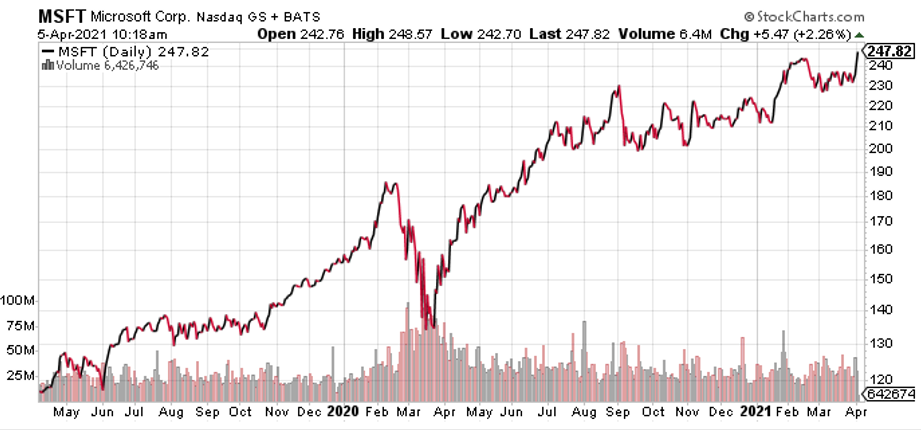Microsoft Transforms Sci-Fi Into a Digital Battlefield
Soldiers equipped with augmented reality (AR) headsets are a staple in science fiction films. Everything is connected and digital. Well, last week, sci-fi became a reality.
On Wednesday, the United States Army announced that Microsoft Corp. (Nasdaq: MSFT) had been awarded a $22-billion contract to supply as many as 120,000 AR headsets for use on the battlefield.
It’s the shape of things to come. Investors should strongly consider climbing aboard now.
To be clear, Microsoft product managers have been cultivating a relationship with the military for many years. The Redmond, Washington-based company won a $480-million military contract in 2019 to modify a variant of its consumer HoloLens AR headset. The so-called Integrated Visual Augmentation System (IVAS) is capable of displaying 3D images, thermal imaging, information based on location and even building schematics according to an April 2019 report from CNBC.
Related Post: Microsoft’s Earnings Proves Enterprise Spending’s Back
The journalist compared the experience of wearing IVAS to a real-life “Call of Duty,” the popular Activision Blizzard, Inc. (Nasdaq: ATVI) video game title. The important difference is the headset puts actual soldiers inside a connected network system. Administrators can see the trooper’s heart rate, position in the field and what they are seeing in theater. Soldiers become real-time, connected data points.
Warfare is undergoing a digital transformation, and the implications are immense.
Better training is the most obvious benefit. Connected soldiers can accurately measure their progress as they participate in real-world marksman and positioning drills. Service people who tested the early IVAS devices said it was a combat multiplier, meaning it made wearers’ magnitudes more deadly.
And full-network connectivity means commanders get real-time battlefield visuals from multiple sets of eyes. Soldiers effectively become highly trained, intelligent sensors in the field.
Electronic sensors have played a big role in the development of IVAS, too. FLIR Systems, a thermal imaging company that was recently acquired by Teledyne Technologies Inc. (NYSE: TDY), is one of 12 partners supplying components to the venture.
The development process is novel. The United States military normally treads slowly with new technologies, often bypassing technology leaders for trusted partners from the defense sector. The IVAS process was built for speed.
In the course of less than three years, IVAS has progressed from a modified HoloLens headset to a highly specialized, cloud-based device Army leaders want to deploy to 120,000 soldiers. This is due to rapid prototyping and the kind of supply chain expertise large nondefense sector companies bring.
IVAS is a mass production, state-of-the-art digital product built in the digital era. Like electric vehicles (EVs), its real strength is software and connectivity.
This is the opportunity many investors continue to miss.
Digital transformation isn’t a buzzword. It’s not hype. Large parts of the commercial, government and military worlds are undergoing this transition now. There are only a handful of businesses globally that are capable of coordinating the process. Better still, the share prices of many of these companies in no way reflect the scope of what is happening.
Microsoft is best known for its Office productivity software, yet other parts of its business are growing even faster and have become more important to future growth. Intelligent Cloud encompasses Microsoft’s cloud-based computing businesses. The hidden strength of devices like IVAS is a big part of data analytics, and computing is carried out in the cloud.
More importantly, these are mostly as-a-service businesses. Revenues are not one and done. They are subscriptions with longer-term visibility. Customers pay year after year for the cloud-based services Microsoft provides. And the kicker is those services can be affixed to a host of new product categories in the works to take advantage of lost-cost digital sensors, software and connectivity.
Related Post: How the Pandemic Has Reinvigorated Microsoft
Microsoft is also building a big, new business in cars that connect to networks and other vehicles to share information, for example.
A decade ago, AR headsets for soldiers seemed like science fiction. Today, those devices are a reality, and Microsoft shareholders are the beneficiary of a $22-billion Army contract.
Other digital transformation categories are in the pipeline. Microsoft is well positioned to take advantage.
Savvy investors should strongly consider buying shares into any weakness.
Best wishes,
Jon D. Markman




